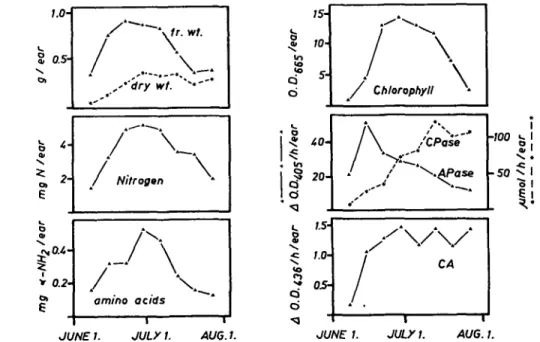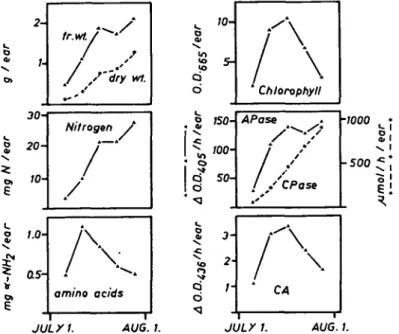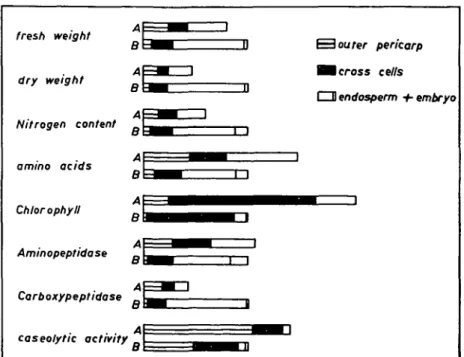Changes in nitrogen contents and in proteolytic activities
in different parts of field-grown wheat ears
(Triticum aestivum L.) during maturation
Urs Feller
Pflanzenphysiologisches Institut, Universitat Bern, Altenbergrain 21, CH-3013 Bern, Switzerland (Received July 15, 1978)
Aminopeptidase, carboxypeptidase and neutral endopeptidase activities were analyzed in glumes and in kernels of field-grown wheat (Triticum aestivum L.) during ear development. Kernels harvested on two dates were subdivided into outer pericarp, cross cells, endosperm and embryo. In developing parts with a net nitrogen influx (young glumes, embryo, endosperm) the aminopeptidase activity is high, but in nitrogen-mobilizing tissues (senescing glumes, outer pericarp) this activity decreases. Carboxy-peptidase is most active in fully expanded tissues. Neutral endoCarboxy-peptidase shows the highest activity in the nitrogen mobilizing parts and extremely low activity in the embryo and the endosperm.
Key words: Glumes — Grains — Nitrogen mobilization — Proteolytic activities — Wheat.
In maturing ears, nitrogen-mobilizing tissues and nitrogen sinks are close to-gether. In general, aminopeptidase and carboxypeptidase activities decrease in senescing leaves of cereals and neutral endopeptidase activity increases or remains unchanged (5, 7). A decrease in aminopeptidase activity and an increase in endo-peptidase activity was also observed in the older parts of the root system of corn seedlings (6"). These results suggest that the loss of activity of aminopeptidase and the increase in endopeptidase activity in the neutral pH range are related to nitrogen mobilization from senescing plant parts.
In maturing kernels, azocaseinase activity is found mainly in the pericap {10), and carboxypeptidase activity is high in the pericarp and the endosperm, but very low in the embryo (11). In dormant seeds, the proteases remain active, but during storage for several years at room temperature the activities decrease (12). During germination, the pattern of proteolytic enzymes changes. For example, acidic sulfhydril-endopeptidase and carboxypeptidase are formed and degrade storage proteins (1, 3, 6, 8, 9). In growing parts of the seedling, e.g. root tip or shoot, amino-peptidase activity was high, but endoamino-peptidase and carboxyamino-peptidase remained low (6). These results concerning proteolytic enzymes in maturing, dormant and germi-nating seeds of cereals indicate that the pattern of proteolytic enzymes changes with the physiological status of the seed, e.g. grain filling and germination.
This paper describes the changes in activities of proteases in nitrogen source and sink parts of maturing ears. The different activity patterns and their changes during maturation as related to physiological processes will be discussed.
Materials and methods
Plant materials
Winter wheat (Triticum aestivum L., cv. Probus) grown in the field was sampled at weekly intervals from ear development to maturity. Whole shoots were trans-ported in plastic bags on ice to the laboratory, then the ears were cut off and stored in plastic bags in a freezer (— 20°C) until the end of the growth period. The time courses of development in glumes and whole kernels were studied in three series of extracts. The analysis of the different parts of the kernels was done in duplicate. All data are expressed on a "per ear" basis.
Enzyme extraction
For the enzyme assays, glumes (consisting of glume, lemma and palea) and ker-nels of two ears (glumes of four ears for harvest date June 6) were taken. Before an thesis, anthers and pistils were removed. All kernels of one ear were used when the kernels were subdivided into the different parts. 2.5 to 6 ml extraction medium (50 mM acetate buffer, pH 5.4, containing 1 % Polyclar AT and 0.1% mercaptoetha-nol) per gram fresh weight was used. The samples were homogenized with a Poly-tron homogenizer (Kinematica, Luzern) first at low speed for 1 min and then at full speed for 5 sec. The homogenate was passed through miracloth and centrifuged for
10 min at 4,000 X g. The supernatant was desalted by passage through a Sephadex G-25 column as described earlier (5). The eluate was used as the enzyme source for the assays.
Enzyme assays
Aminopeptideas was assayed as the rate of hydrolysis of L-leucine-/>-nitroanilide (3), carboxypeptidase as the rate of hydrolysis of N-carbobenzoxy-L-phenylalanine-L-alanine (15) and neutral endopeptidase as the rate of hydrolysis of azocasein at pH 7.5, as described earlier (7). All enzyme activities were determined at 37°C. Carboxypeptidase activity is expressed in ,umoles per hr per ear. Aminopeptidase and endopeptidase activities are expressed in relative units, where one relative unit of aminopeptidase corresponds to 0.435 /*mole of substrate hydrolyzed per hr per ear and one relative unit of endopeptidase activity is equal to 0.196 mg azocasein hydro-lyzed per hr per ear.
Total reduced nitrogen, amino nitrogen, chlorophyll, fresh weight and dry weight
For the measurements of the total reduced nitrogen, free amino groups and chlorophyll, a separate set of ears was homogenized in chilled acetone. The medium per fresh weight ratio was the same as for the enzyme extracts. For the amino acid and chlorophyll determinations, a part of the homogenate was centrifuged for 5 min at 4,000 X g. An aliquot of the well-mixed suspension was used to analyze the total reduced nitrogen. The chlorophyll content is expressed in relative units (absor-bance at 665 nm). Amino acids were determined with the ninhydring reagent (4) and the total reduced nitrogen by an ultramicro-Kjeldahl procedure (2). The fresh weight and dry weight (72 hr at 70cC) were measured in a third set of ears.
Results
Nitrogen content and proteolytic activities in glumes
The time courses of nitrogen content and proteolytic activities in glumes are shown in Fig. 1. The first parts of the curves show the development of the ear with increasing fresh weight, dry weight, nitrogen and chlorophyll contents. The free amino groups are low, but increase during this phase. Aminopeptidase shows the highest activity in expanding glumes and then decreases, although total reduced nitrogen initially remains high. In contrast, carboxypeptidase and neutral endo-peptidase activities are low in young glumes and increase with age.
The decrease in nitrogen content in the glumes is well correlated with the crease in nitrogen content in the kernels (Fig. 2). First the free amino groups in-crease in the glumes without a loss of total reduced nitrogen, but during the grain filling period a sharp decrease in the amino nitrogen occurs simultaneously with the decrease in the total reduced nitrogen. These results indicate that a net protein hydrolysis is initiated before a decrease in nitrogen (net export of nitrogen) starts in the glumes. The increases in carboxypeptidase and neutral endopeptidase (caseo-lytic activity at pH 7.5) occur before the amino acid content increases, but the amino-peptidase activity has already decreased. Carboxyamino-peptidase and neutral endo-peptidase both show maximum activities during nitrogen mobilization and may be the major factors involved in degradation of functional proteins to low molecular weight compounds for translocation to the kernels.
1.0-g 0.5-\ 6 * 0.2-~Vtr. wt. ry wt. / / Nitrogen
• V
ammo acids 75-| 70-Q 6 5- 40-I n 20-Q O ;.5- 7.0- 05-/ Chlorophyll \-100 < •SOJUNE 1. JULX1. AUG. 1. JUNE 7. JULX1. AUG. 1.
Fig. 1. Changes in nitrogen content and in proteolytic activities of wheat glumes during maturation. G l u m e s (consisting of glume, lemma and palea) of field-grown wheat harvested at weekly intervals during the reproductive phase were analyzed for fresh weight (fr. wt.), dry weight (dry wt.), total reduced nitro-gen, amino acids, chlorophyll, carboxypeptidase (CPase), aminopeptidase (APase) and for neutral caseolytic activity (CA). All data represent the average of triplicate determinations and are expressed on a "per ear" basis.
Nitrogen content and proteolytic activities in kernels
The increase in fresh weight, dry weight and nitrogen content reflects the stage of grain filling (Fig. 2). The free amino acid level is high in the milky stage and then decreases with increasing synthesis of storage proteins. Chlorophyll, which is pre-sent only in cross cells is an indicator of the senescence of the chlorophyll-containing cells. As expected, chlorophyll shows a maximum during kernel maturation (de-velopment and senescence of cross cells). In the whole kernel, both exopeptidases (aminopeptidase and carboxypeptidase) increase during the grain filling period, but the increase in aminopeptidase occurs earlier. The neutral endopeptidase (caseoly-tic activity) shows a maximum similar to the chlorophyll content. Because late in maturation the whole kernel is a mixture of senescing tissues (outer pericarp, cross cells) and developing parts with net protein synthesis (embryo, endopserm), inter-pretation of these data is difficult. Therefore anaylses were done also for the dif-ferent parts of the grain, as described in the next section.
Distribution of nitrogen and proteolytic activities in different grain parts
The grains were separated into outer pericarp, chlorophyll-containing cross cells, endosperm and embryo, and the different fractions were analyzed separately (Fig. 3). The distribution of chlorophyll, which is present in cross cells only, in-dicates some contamination in the other fractions. First the outer pericarp senesces followed by cross cells as indicated by the loss of nitrogen, fresh weight, dry weight and chlorophyll. It can be seen in Fig. 2 that at harvest date A the chlorophyll is still increasing, but harvest date B is after the maximum chlorophyll level. The proteolytic enzymes are unequally distributed in the different parts of the kernel.
o a, £ o to-Ot 23 0 - 10- 1.0- as-/ as-/"dry wt. Nitrogen / \ amino acids 10-in <o 10 Q
, s
;5°-^ 100-1 o CS* 50-C)
1
Q 6 3- 2-I-A
ChlorophyllI
APase\
CA •1000 -500 1. AUG. I. JULXI. AUG. I.Fig. 2. Changes in nitrogen content and in proteolytic activities of wheat kernels during maturation. All data represent the average of the triplicate determinations and are expressed on a "per ear" basis. For abbreviations see Fig. 1.
fresh weight dry weight Nitrogen content o amino acids Chlorophyll Aminopeptidase Carboxypeptidase caseolytic activity a S outer pericarp I B cross cells CD endosperm + embryo
Fig. 3. Distribution of nitrogen and of proteolytic activities in kernels of field-grown wheat. The value for the whole kernel of harvest date B is used as a relative unit to express the data. Embryo and endosperm were separated only for harvest date B as indicated by the separation line (endosperm left side, embryo right side). All data represent the average of two independent determinations. Harvest date A: July 6th. Harvest date B: July 20th.
Aminopeptidase activity is extremely high in the embryo. In the outer pericarp and in the cross cells this activity decreases during senescence. Carboxypeptidase also loses its activity during senescence as indicated by the decrease in activity in the outer pericarp from harvest date A to B. Cross cells are still in the early stages of senescence at harvest date B, nitrogen and chlorophyll contents are still high and carboxypeptidase remains active. The neutral endopeptidase is mainly restricted to the outer pericarp and to the cross cells. While in the outer pericarp this activity has already decreased between harvest dates A and B, it increased in the cross cells. The localization of neutral endopeptidase activity in the outer pericarp and the cross cells and its activity change during nitrogen mobilization indicate its association with ageing processes in senescing parts of the maturing kernel.
Discussion
Aminopeptidase is most active in growing and active tissues (developing glumes, embryo, endosperm and pericarp in early stages). This is consistent with earlier results obtained with other plant tissues (5-7). Aminopeptidase activity is always low and decreases in nitrogen-mobilizing tissues (senescing glumes and pericarp).
Carboxypeptidase activity is high in fully-expanded active tissues and also during mobilization processes (germination and senescence). High
carboxypept-idase activities in maturing endosperm and in photosynthesizing leaves (5, 7, / / ) indicate that this enzyme is not restricted to nitrogen-mobilizing tissues, but its high activity can contribute to the rapid protein degradation in the mobilization processes. In embryonic and expanding tissues this activity remains extremely low.
Higher activities of neutral endopeptidase are present only in senescing ear tissues. This is consistent with results from maturing kernels (10), senescing roots (6~) and senescing leaves (5, 7). Because this activity remains low in germinating seeds, neutral endopeptidase appears to be involved specifically in the degradation of functional proteins during senescence, but not in the breakdown of storage pro-teins. The increase in endopeptidase activity occurs in glumes and in the pericarp before net nitrogen export starts. This fact suggests diat either the enzyme is not evenly distributed in glumes as observed in cereal leaves (5), or that the protein mobilization is regulated by factors other than the amount of this enzyme as sug-gested for pea leaves (14). However, the presence in senescing and the absence in nonsenescing tissues and the time courses of this enzyme support the suggestion that neutral endopeptidase is a major factor in protein mobilization from senescing ear tissues.
The sum of the activities in different parts of the kernel was not different from the activity measured in extracts of the whole kernel of the same age (for all 3 enzymes analyzed). Therefore the marked differences observed in different tissues are not due to the presence of inhibitors. This is consistent with results indicating that plant proteinase inhibitors often do not inhibit endogenous proteolytic enzymes (13). The question whether increasing activities are due to de novo synthesis of the enzyme protein or to activation of precursors already present, remains open.
I thank Landwirtschaftliche Schule Rutti in Zollikofen for growing the plants and Dr. R. Thomas for assistance in preparing the manuscript. The work was supported by Schweizerischer National-fonds (Project 3.259-0.77).
References
( 1) Basha, S. M. M. and L. Beevers: The development of proteolytic activity and protein degrada-tion during the germinadegrada-tion of Pisum sativum L. Planta 124: 77-87 (1975).
( 2 ) Bohley, P.: Reihenbestimmungen von Stickstoff im UltramikromaBstab. Hoppe Seyler's Z.
Physiol. Chem. 348: 100-110 (1967).
( 3 ) Chrispeels, M. J. and D. Boulter: Control of storage protein metabolism in the cotyledons of germinating mung beans: role of endopeptidase. Plant Physiol. 55: 1031—1037 (1975). ( 4 ) Cramer, F.: Papierchromatographie. p. 102. Verlag Chemie, Weinheim, 1958.
( 5 ) Feller, U. K., T.-S.T. Soong and R. H. Hageman: Leaf proteolytic activities and senescence during grain development of field-grown corn (Zea mays L.). Plant Physiol. 59: 290-294 (1977). ( 6) Feller, U. K., T.-S. T. Soong and R. H. Hageman: Patterns of proteolytic activities in different
tissues of germinating corn (Zea mays L.). Planta 140: 155-162 (1978).
( 7) Feller, U. and K. H. Erismann: Veranderungen des Gaswechsels und der Aktivitaten proteolyt-ischer Enzyme wahrend der Seneszenz von Weizenblattern (Triticwn aestivum L.). Z.
Pfianzen-physiol. in press.
( 8) Harvey, B. M. R. and A. Oaks: The hydrolysis of endosperm protein in Zea mays. Plaid Physiol. 53: 453-457 (1974).
( 9) Jacobsen, J. V. and J. E. Varner: Gibberellic acid-induced synthesis of protease by isolated aleurone layers of barley. Plant Physiol. 42: 1596-1600 (1967).
(70) Kruger, J. E.: Changes in the levels of proteolytic enzymes from hard red spring wheat during growth and maturation. Cereal Chtm. 50: 122-131 (1973).
(77) Kruger, J. E. and K. Preston: The distribution of carboxypeptidases in anatomical tissues of developing and germinating wheat kernels, ibid. 54: 167-174 (1977).
(12) Nowak, J. and T. Mierzwinska: Activity of proteolytic enzymes in rye seeds of different ages. Z. Pflanzenphysiol. 86: 15-22 (1978).
(73) Ryan, C. A.: Proteolytic enzymes and their inhibitors in plants. Ann. Rev. Plant Physiol. 24: 173-196 (1973).
(If) Storey, R. and L. Beevers: Proteolytic activity in relationship to senescence and cotyledonary
development in Pisum sativwn L. Planta 137: 37-44 (1977).
(75) Visuri, K., J. Mikola and T. M. Enari: Isolation and partial characterization of a carboxy-peptidase from barley. Eva. J. Biochem. 7: 193-199 (1969).


